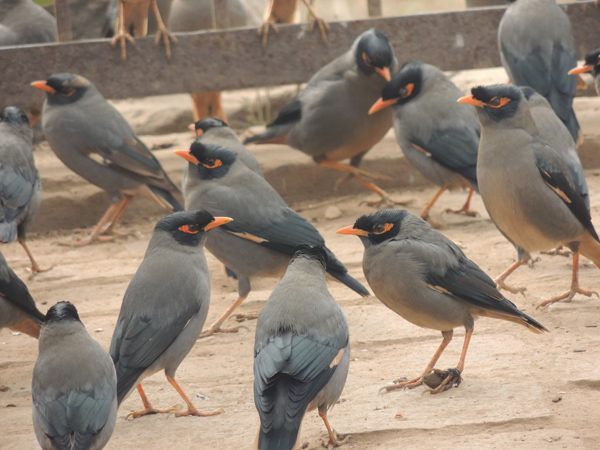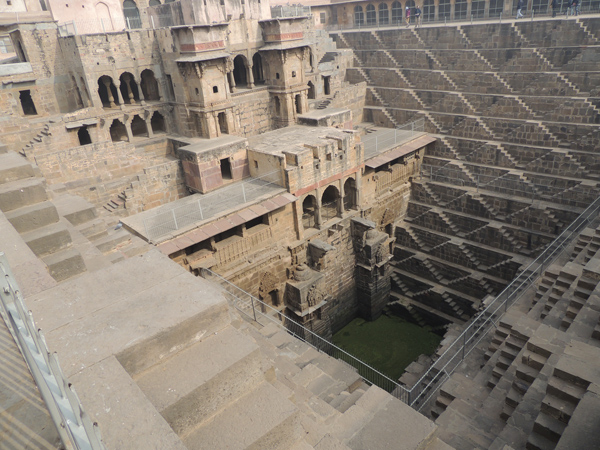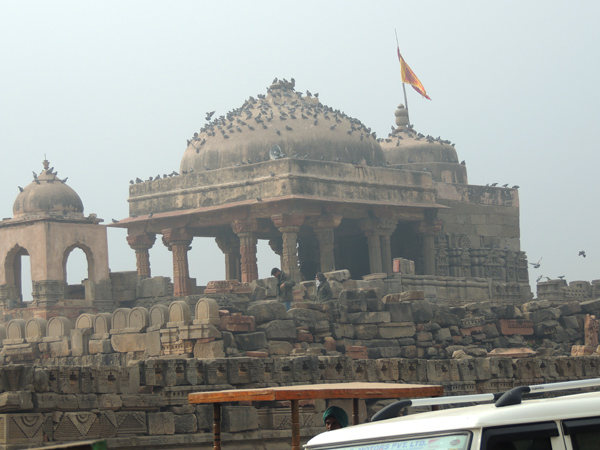|
|
|
Chand Baori
Wednesday, December 25 2019
location: room 101, Udai Vilas Palace, Bharatpur, Rajasthan, India
[REDACTED]
We packed up our stuff and loaded into the bus for our next destination on the tour, the old kingdom of Kishangarh. Along the way, we stopped in a dusty village called Abhaneri to see Chand Baori, the largest "step well" in all of India. I'd never heard of step wells, so you can imagine my amazement to see one. It was like an inverse pyramid cut down into the ground, its sloping walls converging on three sides towards a smallish pool at the bottom. On those three walls was an amazingly regular pattern of criss-crossing steps, something looking like a real-life imagining of a print by M.C. Escher. The fourth side of the hole consisted of an ornate multi-level façade resembling the wall of a building that had somehow been buried. The structure was to provide access to water for local villagers, and seemed like a lot of trouble for a service that could have been more easily provided by a much smaller vertical hole and a set of winches for raising and lowering buckets. But perhaps step wells date from a time after which geometrically-precise structures could be built but before the invention of the block and tackle. Step wells are common in India, suggesting that time spanned centuries. (Chand Baori is about 500 years old.)
As we were coming out of Chand Baori, our Indian fixer J had a local magician perform a number of sleight-of-hand tricks for us, most involving coins being produced out of nothing or currency being "converted" by small wooden contraptions. Almost as good as the magic itself was the sing-song cadence of the narration in heavily-accented English.
For lunch we went to a palace restaurant out in the country which had a bit of the high-end colonial feel to it. That's how it felt inside, but when we went out in back on a raised platform high above a fenced area, we saw very dark-skinned goat herder down below who somehow thought he could convince us to throw rupees down to him just for the pleasure of seeing something so rustic (or so I gathered). Instead, my nephew and I posed for some pictures Lee wanted to take of purposefully-douchey Americans hanging out in opulence in India, which was an easy picture to set up on some chairs in the outdoors hangout area. The food at this place was very fresh and organic but disappointingly bland, suggesting it catered to gringos such as, well, us. Fortunately, they had beer and wine available for those who wanted to pay extra for it. So I got a small (350 mL) bottle of red wine, which I shared with a few compatriots. The surprise came when I had to settle up: the guy asked for 1200 rupees for that tiny bottle. That's like $16, which was the price one might more expect in New York City, not rural India. But that's how India is: a heaping ricebowl of grinding poverty with occasional cumin seeds of first-world opulence.
We drove through Jaipur but did not stop. The thing that most struck me about that city was the abundance of flying kites hovering overhead. But most of the kites were dead ones that had ended up in powerlines or trees.
When driving from place to place in a bus, one is treated to a constant series of brief clips of life in the land through which you're passing. In India, there are the many cows, dogs, motorcycles, and lavishly decorated trucks with black tassels (there to keep away the evil eye, whatever that is). Periodically you'll see a man on the side of the road pissing or even someone stooped in the process of shitting, neither of which are things people feel much need to hide from strangers. One thing I expected to see more of, given all the cows and dogs walking amid fast-moving vehicles, was dead animals. The other day I thought I'd seen a dead cow on a sidewalk with people hanging around nearby like it was no big deal, but I'd never seen a single incident of roadkill. Perhaps the dogs, pigs, and vultures clean up the corpses soon after they become available. Today I caught a glimpse of a pack of dogs tearing apart something, but the place where the dead were hard not to notice was along Route 48 near Bandar Seendri. There I saw a number of dead cows that had been tied by the neck to trees. Had they been put there and forgotten? Or had they been put there to die? One of them had a hole eaten through its side, but it seems the dogs (and jackals) weren't making quick work of them. I also saw at least one dead sheep along this stretch of highway.
Our final destination today was the Phool Mahal palace on the south shore of Gundolav Lake, ancient manmade reservoir in Kishangarh. Unlike the last place we'd stayed, the Phool Mahal was an actual royal palace, located just north of an imposing hilltop castle. On arrival, we were greeted with floral garlands and drinks of limewater and salt (which tasted like non-alcoholic margaritas). Each of us were given rooms, all of them grand suites suitable for a prince. Ours was up a steep flight of high-stepped marble stairs and came with an expansive view of the lake. I soon discovered an impressive marble staircase to the roof, which features a series of ever-higher roofs, all of which were paved with concrete and suitable for walking on. There were even occasional chairs and tables here on the roof, suggesting people spent time up there hanging out.
Gretchen's parents soon discovered they'd been given a suite adjacent to ours up that same flight of stairs. But Gretchen's mother couldn't easily climb such challenging steps, so they soon swapped their room for the ground-floor suite assigned to their grandson and daughter-in-law. This meant that mother and son would have to sleep together in a king-sized bed, but they insisted that wouldn't be a problem, and thus there was no need for our American fixer Zach to give then am additional mattress from his room, the only one without any views.
Tonight before dinner an Indian folk band performed in banquet hall, and when I arrived they'd managed to get everyone dancing. Then they relocated outside, facing a set of chairs put out for us to sit in in the grassy area just outside. My nephew is a music theory nerd and joined the band for some of their performance, though they mostly had him handle videography using a smart phone. The performance delayed dinner by a couple hours, though the staff did the best to keep us happy with endless rounds of papadum and as much beer or rum as we cared to drink. The folk music wasn't particularly good, featuring the endless droning of a harmonium over wailing vocals and pounding tablas. According to Singhji (our main Indian guide), the lead vocalist had lost both his hands while working on an accidentally-energized powerline, so as he sang he gesticulated using an artificial right hand. The prosthesis matched his skin color but was very shiny and decidedly undersized, giving his performance a decidedly David Lynchian quality. This persisted when "Santa Claus" arrived. He was a typical local, meaning he was very thin, and he wore a form-fitting red Santa suit and an unnecessarily creepy plastic Santa mask. He came to each of us, dispensing various gifts, such as a tiny rolled-up painting and a set of matryoshka bowls. Dinner ended up being so delayed by the music that our first round of soup was brought to us outside as we sat in the audience. It was a cloyingly sweet tomato soup that both Gretchen and I had to dump into the grass. Fortunately, when dinner finally came, it didn't disappoint.
After dinner, we got into a conversation with an older couple from Portland, Oregon named Betty and Richard. They took us back to their suite, a beautiful corner unit beneath one of the round turret-like structures. Their walls featured paintings of bathing beauties, which would be considered racy even in contemporary India. They kept finding us (well, me) alcoholic drinks and telling us stories in rapid-fire delivery, interrupting each other to fill in details as needed. When talking about European travel, they were adamant that the only travel guides of any use are written by a man named Rick Steve. I think the only story we got in was the one about us hitchhiking in Scotland.

Gray-black myna birds. They were everywhere in the town near the Chand Baori step well, but the only birds within the step well itself were pigeons.
Click to enlarge.

Chand Baori step well. It's amazing.
Click to enlarge.

Temple adjacent to the Chand Baori step well.
For linking purposes this article's URL is:
http://asecular.com/blog.php?191225 feedback
previous | next |


